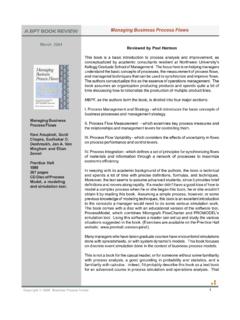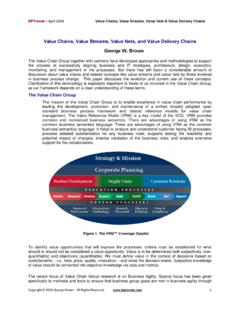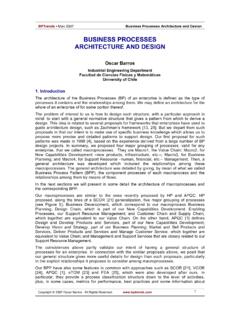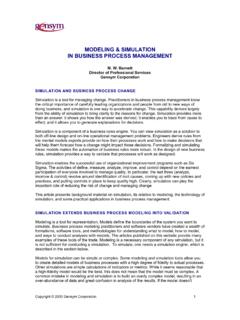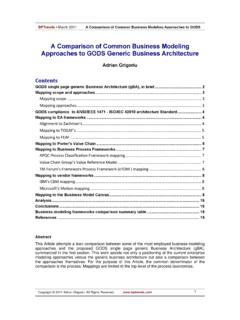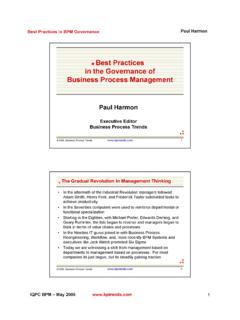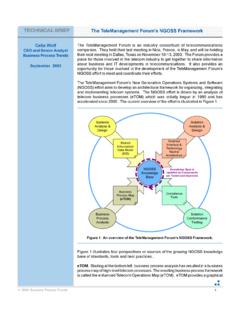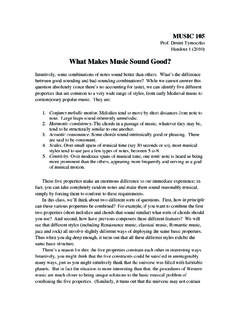Transcription of Rob Davis - BPTrends
1 1 BPTrends November 2009 what makes a good process?Copyright 2009 IDS Scheer. All Rights Reserved. what makes a good process? Rob Davis Everyone wants a good process. Our businesses would be more profitable if we had them. But do we know what a good process is? Would we recognized one if we saw it? And how do we ensure we can design them? So what makes a good process ? This is a question that I am often asked. Usually the person asking is looking for a simple answer: One that has no more than 10 task boxes or only has two handovers or one that looks long and thin. Of course, things are not that simple, and there is a difference between what makes a good process and what makes a good process model. It is often the latter that people are really asking about, but a process model is just that; it is a model, it is not the real thing. It is perfectly possible to have a good process model of a poor process, but you cannot have a really good process without a good model or design.
2 So in this article I would like to explore what makes a good process and what we need to model to ensure that we get a good process. So, first of all, what is a process? Simply put, we can say that a process is the definition of the tasks and the sequence of those tasks necessary to fulfill an objective. Normally we think about business objectives, but the important thing is that the process must deliver something (a product or service) to someone (or some organization) outside of the process, and what is delivered must be of value to that person or organization. However, that alone is not enough for a business process; the process must have some value to the business itself. Normally that means someone, the customer or a client, will pay for the product or service delivered by the process. But that is not enough either; the objective of the process must also align with corporate values and strategy.
3 It is easy to think up money making schemes a business could operate that would benefit other people, but these may not be appropriate if they are not part of the core business of the organization. So, summarizing, we can identify our first set of criteria for a good process; it must 1. Deliver something of value to someone outside of the process, 2. Create value for the organization operating the process, 3. Align with corporate values and strategy. So we can see that processes do not stand by themselves in isolation, and, hence, when designing or modeling a process, we need to think about more than the process flow. A process model must describe (see Fig. 1): the definition of tasks, the sequence of tasks, the resources needed to operate them, the environment in which they operate, the business objectives they fulfil. Only when we consider the resources required, and the environment in which the process must operate ( , what laws, regulations, business policies, and constraints apply), can we truly start to understand what a process really is.
4 Every input to the organization and output from it will be connected to a process. 2 BPTrends November 2009 what makes a good process?Copyright 2009 IDS Scheer. All Rights Reserved. Figure 1. Key Aspects of a Process Model Having defined the basic context and characteristics of a process, we can start to think some more about what would make such a process a good process. a good process is one that is Effective Efficient Relevant Valid Usable Used Reused Managed Measured Effective First, and most important. the process must do what it is supposed to; it must be simple and make life better for all concerned. It must demonstrably deliver value to the customers. It must satisfy and delight them. In satisfying them, it must meet their needs and fulfill the contract or agreement that has been made with them.
5 So it must deliver what was agreed, on time and for the price that was agreed. The product or service must work, and it must continue to work for a reasonable period of time. This applies whether the process is delivering to an external customer or to other departments or users in the same organization. Often these customer requirements are called the Voice of the Customer, which may also include service level guarantees imposed by a regulator on behalf of the customer. Being customer focused or taking what is often called an outside in approach, is a major goal of process effectiveness, but it is not the only goal. The process must also align with the Voice of the Business, which defines the business strategy, values, and policies. We can t just respond to everything the customer wants as this may be too costly or not part of the business strategy. 3 BPTrends November 2009 what makes a good process?
6 Copyright 2009 IDS Scheer. All Rights Reserved. Efficient The Voice of the Business is also concerned with the efficiency of the process and will impose constraints that ensure the business is profitable or ensures that a not-for-profit organization operates within its budget. The process must be devoid of waste, unnecessary steps, multiple hand-overs and other wasteful characteristics. The process must use available resources to best effect and, ideally, as I will mention later, reuse common processes and IT services. So the design and operation of a good process must serve two masters the Voice of the Customer and the Voice of the Business. The way in which it does that or, rather, the measurement of how effectively it does it, is often called the Voice of the Process (see Fig. 2). Figure 2. Process Drivers and Measures Relevant The process must, of course, be relevant to the business, but what does that mean?
7 Aren t all the processes relevant? Well, of course, they are, but inevitably some are more important than others, and some are more appropriate to focus on than others. Essentially, we use processes because we don t want to leave the operation of our business to chance. For most businesses, it is important that the main activities are consistent, repeatable, and of a high quality. We want our customers to have a good experience and essentially the same experience each time they contact us. In the first instance, we want to concentrate on those processes that deliver and maintain the service to the customer and the cash flow to the business. It is important to look at the whole rather than the part and not to dwell on isolated subprocesses, but to look along the length of the end-to-end process that takes a customer order at the start, delivers the product, and receives payment at the end.
8 So this order-to-cash process is one of the relevant or core business processes that flow through the different business functions or departments (see Fig. 3). It is vital to think through the process end-to-end. A process that delivers an excellent product to the customer is of no use if it doesn t also describe how they should pay for it! A way to understand the structure of the business processes, and that will add value, is to construct a process architecture or process landscape. a good process is one that fits into the corporate process architecture. 4 BPTrends November 2009 what makes a good process?Copyright 2009 IDS Scheer. All Rights Reserved. Figure 3. Value-driven End-to-End Processes Other E2E processes include fault-to-repair and concept to market. Often business do not get around to thinking about concept to market the new product introduction process as it is not seen as an important operational process.
9 It is often thought of as a supporting process or maybe not even a process at all, but a project. However, it is the C2M process that ensures that new products and services meet customer needs and corporate strategy and that effective and efficient order-to-cash and fault-to-repair processes are in place to support them. It also ensures that processes and IT components are reused to make best use of the corporate infrastructure. So maybe we should think about concentrating on designing C2M first so it can build the infrastructure and ensure good operational processes are put in place. I will talk about this more in a future article. Valid a good process must be valid; that is to say, it should be sufficiently correct to be valuable and usable. That means we must verify and validate it against the customer and business requirements.
10 You might be surprised that I have said sufficiently correct. Shouldn t processes be completely correct? Well, the thing to keep in mind is that a process design (and a process model) is only a representation of the real thing. It can never represent absolutely every aspect of the real world so it must be correct enough for the purpose for which it will be used. If it is going to be used to develop a completed automated IT driven process, then the model must be tested against all likely scenarios to ensure that it will be robust in all eventualities. If, on the other hand, it is going to be used as a training aid for managers, it might only be necessary to cover a few key scenarios at a high level of abstraction. Even with an automated process it is not possible to cover every possible scenario, and a fault handling route is needed where a person can resolve the problems and issues that occur less frequently.
